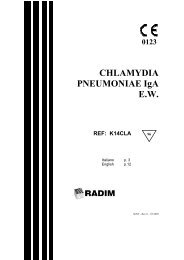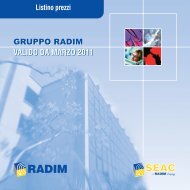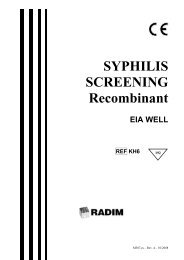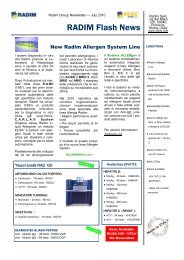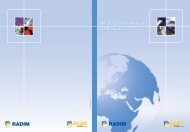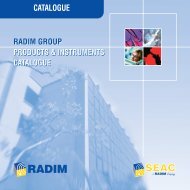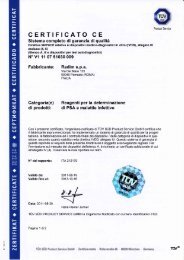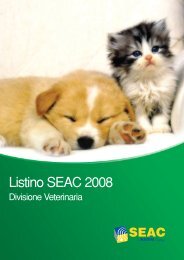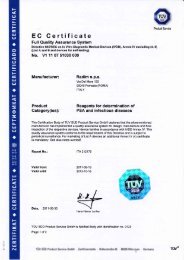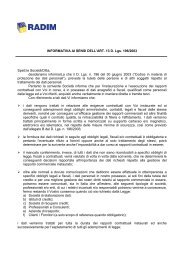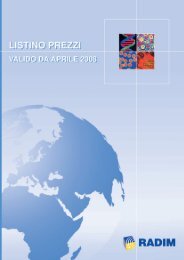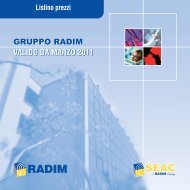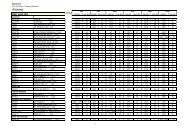testosterone ria ct ref ks24ct - Radim S.p.A.
testosterone ria ct ref ks24ct - Radim S.p.A.
testosterone ria ct ref ks24ct - Radim S.p.A.
Create successful ePaper yourself
Turn your PDF publications into a flip-book with our unique Google optimized e-Paper software.
− Avoid splashing and aerosol formation; in such cases, ca<strong>ref</strong>ully wash with a 3% sodium<br />
hypochlorite solution. Any cleaning mate<strong>ria</strong>l used for that purpose must be treated as potentially<br />
infe<strong>ct</strong>ious and disposed accordingly.<br />
− The sodium azide used as preservative in some reagents may rea<strong>ct</strong> with lead and copper<br />
plumbing; to prevent build-up of explosive metal azides, the reagents should be discarded by<br />
flushing the drain with large amounts of water.<br />
− According to Italian decree D.L. no. 22 dated 05.02.97, in compliance with EEC dire<strong>ct</strong>ives<br />
(91/156/EEC, 91/689/EEC, 94/62/EEC), all waste produ<strong>ct</strong>s originating from either manual and/or<br />
automated processing are classified as hazardous special waste mate<strong>ria</strong>l (European classification<br />
code 180103, infe<strong>ct</strong>ious waste or potentially infe<strong>ct</strong>ious waste). As such, they must be eliminated<br />
(by) delegating them to special enterprises (companies), qualified for waste colle<strong>ct</strong>ion and disposal.<br />
− All radioa<strong>ct</strong>ive waste originating from either manual and/or automated processing, must be<br />
eliminated delegating them to special enterprises, qualified for waste colle<strong>ct</strong>ion and disposal,<br />
according to D.Lgs.241/2000.<br />
− Acquisition, storage, use and disposal of radioa<strong>ct</strong>ive mate<strong>ria</strong>l (liquid and solid) are subje<strong>ct</strong>ed to<br />
regulation and ordination of local authorities.<br />
� Radioa<strong>ct</strong>ivity contents to the <strong>ref</strong>erence date is shown on the kit external label.<br />
SPECIMEN COLLECTION AND PREPARATION<br />
The assay can be performed in serum samples. Highly lipemic or hemolyzed samples must be<br />
discarded. Keep samples at 2-8°C for 1-2 days; for longer periods it is advisable to freeze samples at -<br />
20°C. Make sure that samples are always perfe<strong>ct</strong>ly clear before testing. Repeated freezing and thawing<br />
of samples should be avoided.<br />
ASSAY PROCEDURE<br />
− Allow reagents and samples to warm up at room temperature.<br />
− Mix samples by inversion before use.<br />
1 - Prepare coated tubes for: Zero Calibrator (Bo), Calibrators (1-5), Control Serum and Samples. Use<br />
uncoated tubes for Total A<strong>ct</strong>ivity (T) and Non-specific Binding (NSB).<br />
2 - Pipette 100 µl of each Calibrator, Control Serum and Sample into the corresponding tubes.<br />
3 - Pipette 100 µl of the Zero Calibrator into the Non-specific Binding (NSB) tubes.<br />
4 - Add 500 µl of Radioa<strong>ct</strong>ive Conjugate into all tubes.<br />
5 - Mix on vortex.<br />
6 - Incubate for 60 minutes at 37°C.<br />
7 - Ca<strong>ref</strong>ully aspirate the incubation mixture from all tubes, except those for total a<strong>ct</strong>ivity, with a<br />
vacuum pump or decant by drying the edges of the tubes with blot-paper.<br />
8 - Count the radioa<strong>ct</strong>ivity in the tubes for 1 minute by using a gamma counter. We suggest to check<br />
the background of the instrument before counting the assay. In order to avoid va<strong>ria</strong>tions in the<br />
sensitivity of the system, the background should be reduced to a minimum or adjusted properly.<br />
ASSAY SCHEME: see p. 31<br />
CALCULATION OF RESULTS<br />
Bo Cpm - NSB Cpm<br />
Binding Capacity % = ------------------------------- x 100<br />
T Cpm - NSB Cpm<br />
Percent binding for calibrators, controls and samples =<br />
B Calibrators or Samples Cpm - NSB Cpm<br />
-----% = ----------------------------------------------------- x 100<br />
Bo Bo Cpm - NSB Cpm<br />
Draw a calibration curve on logit-log or semi-log graph paper, by plotting the B/Bo% of each calibrator (yaxis)<br />
against the relative concentration (x-axis).<br />
Calculate the B/Bo% for each sample and read the concentration by interpolating on the calibration<br />
curve in order to obtain the Testosterone concentration in the tested samples, expressed in ng/mL.<br />
EXAMPLE OF CALCULATION<br />
KS24CT TESTOSTERONE RIA CT<br />
M104 - Rev.10 – 09/2007 - Pag. 10/32



